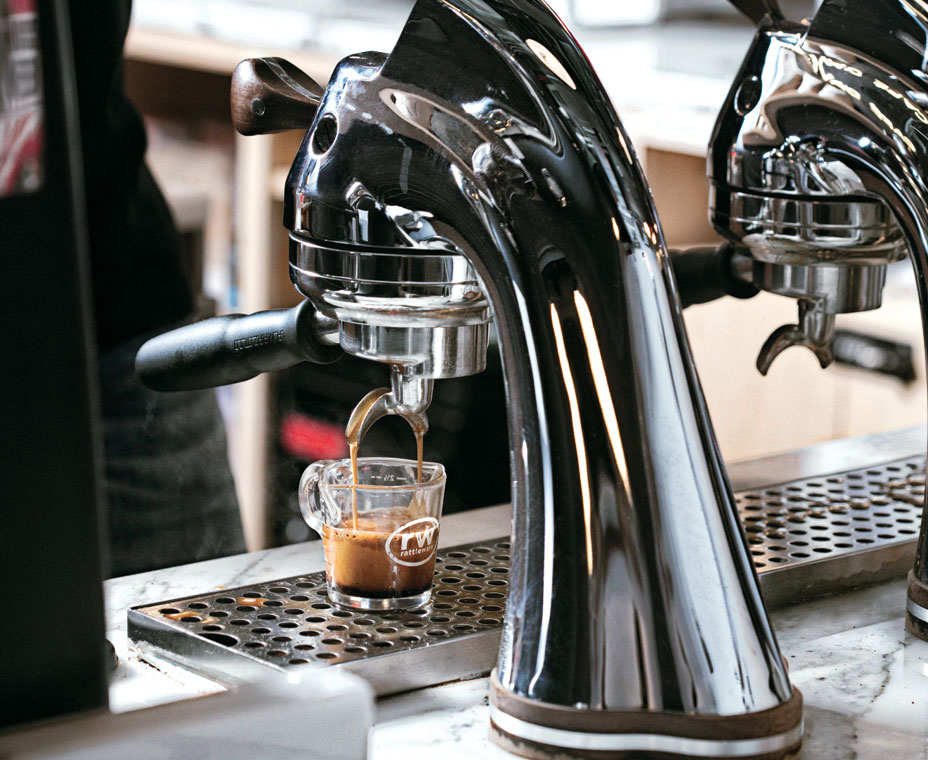Coffee isn’t just a morning pick-me-up anymore. These days, Americans have high standards for their drip coffees, espressos, and iced and blended beverages. Coffee’s third wave—a movement wherein consumers value coffee’s origin and roast even more than its jolting properties—has led to a growth in gourmet coffee options from vendors and coffee houses alike.
According to Mintel data, coffee shops continued to boom in 2017, with sales hitting $23.4 billion last year—up 41 percent over 2011. Mintel predicts coffee-shop sales will reach $28.7 billion by 2021.
While Starbucks and other large chains like Peet’s and Caribou Coffee have reached nearly every corner of the U.S., a growing crop of artisan coffee shops has also taken root, not only as trendy destinations for premium coffee, but also as wholesale coffee roasters. California-based Philz Coffee and Blue Bottle Coffee have each grown to dozens of locations in millennial enclaves; Birmingham, Alabama’s Revelator Coffee Company is hoping to do the same across the South. Portland, Oregon’s Stumptown Coffee Roasters and Chicago’s Intelligentsia Coffee & Tea are roasting both single-origin coffees and proprietary blends for their own shops as well as for many national restaurants.
So what’s so great about their coffee? Coffee companies responsibly source high-quality Arabica beans from places like Guatemala, Costa Rica, and Ethiopia. And by controlling the blending and roasting processes, they’re able to impart signature flavors to their coffees.
Stumptown marketing director Mallory Pilcher says that while today’s consumer preferences are varied with coffee, people typically want something that is “clean, sweet, and balanced.” The favorite blend at Stumptown, she adds, has chocolate and citrus notes—but customers aren’t afraid to try outside-the-box roasts.
“Any of our single origins from Ethiopia and Kenya always prove to be pretty wild,” she says. “African heirloom varietals are mysterious, magical coffee experiences.”
Café D’Avignon, a three-unit operation in New York, is one shop that sources Stumptown beans. The brand installed a Modbar in its newest location to make the coffee-making process more like a cocktail bar (the modular brewing equipment, which includes steam, espresso, and pour-over gear, gives customers a chance to stand and watch their baristas craft their beverages). Chicago’s Werewolf Coffee also uses Stumptown, and Lindsey Reason, a barista with the shop, says popular roasts feature chocolate and fruit notes.
Brand spotlight /
“Werewolf is all about taking culinary inspirations and applying them to our coffee beverage offerings, because after all, coffee is a fruit,” she says. “There are a wide amount of flavors that pair beautifully with coffee. A favorite has to be our seasonal drink ‘The Shakedown’; it’s a cocktail-inspired espresso drink that pairs Passion House Baseline espresso with a star anise and pomegranate syrup. The sweet acidity from the pomegranate and the juiciness of the anise pair really well with espresso.”
While some coffee shops take the in-store experience to something near high art, others recognize that customers sometimes just want a quick, convenient cup of Joe. Two regional brands have thrived as drive-thru-only coffee stands. Oregon-based Dutch Bros Coffee, founded in 1992 by brothers Dane and Travis Boersma, has grown to more than 260 locations in seven states. Meanwhile, Scooter’s Coffee, based in Omaha, Nebraska, has expanded to more than 200 locations in 15 states since it launched in 1998. Todd Graeve, Scooter’s CEO, says the franchise’s 450-square-foot, freestanding drive-thru unit is designed for high-traffic real estate along the morning commute.
Scooter’s serves shade-grown coffee, a method that protects the biodiversity of the environment in which the coffee was grown. “By sourcing shade-grown coffee, Scooter’s and its customers are able to help with rainforest preservation, care for the habitats of local plant and animal species, and encourage the quality of life of families in the countries where we source,” Graeve says.
Of course, coffee shops aren’t Americans’ only destination for a great cup of Joe. The coffee market is massive; a 2017 survey from the National Coffee Association (NCA) found that 62 percent of Americans drink at least one cup of coffee per day. Meanwhile, a Gallup study from 2015 found that the average coffee drinker consumes 2.7 cups of coffee per day. Further, the NCA found that 46 percent of Americans drink coffee outside the home. As such, restaurants have an opportunity to satisfy coffee cravings consistently with a high-quality product. And a number of coffee vendors are making that possible.
Farmer Brothers customer marketing director Janie Page says maple, caramel, honey, and ginger have joined pumpkin spice as trending coffee flavors among consumers. The future of coffee trends may lie in coffee production; she says methods such as storing coffee beans in bourbon casks, barrel-aging coffee, and experimenting with fermentation have been used recently by some companies.
Page says the trendiest coffee beverage today is cold brew. Building off the popularity of iced coffee (in which coffee brewed hot is poured over ice), cold brew is brewed with cold water over the course of 12–24 hours, giving the drink a smooth, rich taste. Datassential found that cold-brew coffee menu mentions grew 635 percent between 2011 and 2016. “Cold beverages are growing faster in fast casual, travel and leisure, and other [quick-service] segments for many reasons, including the natural, clean-label, good-for-you positioning—and it is innovative and new, adding excitement to the beverage category,” Page says. “We have seen flavors ranging from Honey Vanilla Cold Brew to Barrel Aged Whiskey Cold Brew Coffee.”
Erin Slater, senior marketing associate at S&D Coffee & Tea, lists today’s top coffee trends as “coffee with a story,” cold-brew coffee, coffee on draft, frozen coffee, and high-tech coffee equipment.
“The next idea, with regards to cold brew, is how it is dispensed,” says Helen Griffith, S&D’s director of marketing. “Having options for still versus nitro is generating a lot of buzz. Reflecting back on the consumer, they want options, and nitro-infused versus still is slowly becoming table stakes. Flavor variety can be delivered via add-ins.”











